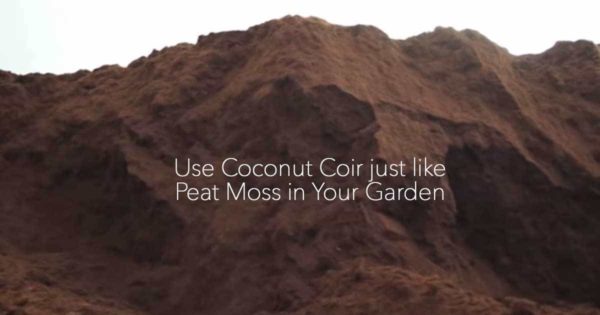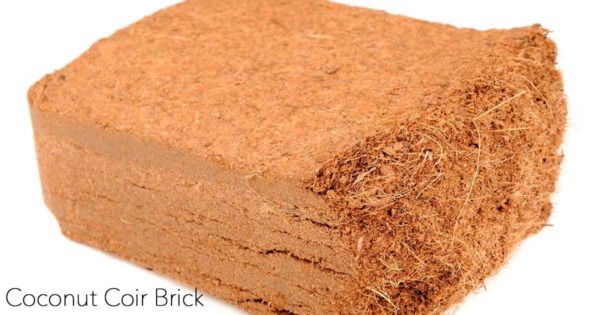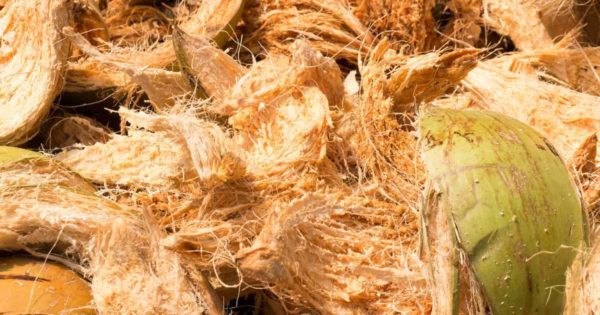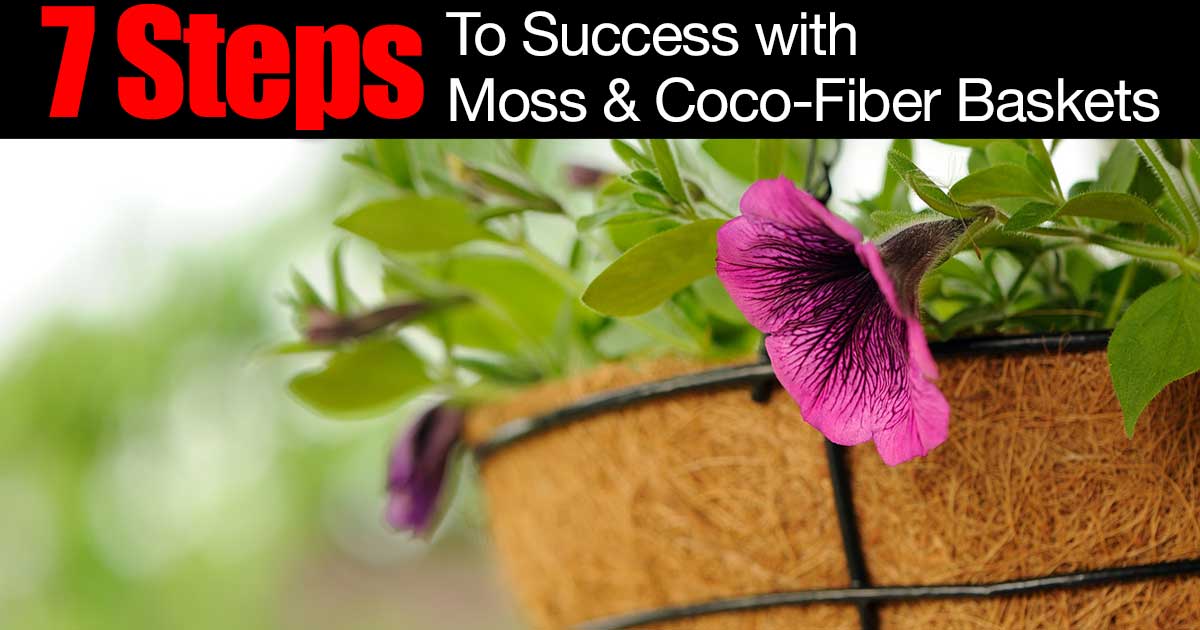Long fiber coconut coir is a traditional lining material for hanging baskets. Did you know that coco coir (a by-product of coconut processing) has found its way for use in potting mixes and hydroponic gardening.
Even if you have not consciously chosen to use coconut coir, you may have noticed it as a fibrous, dark brown component of your favorite potting soil.
In many instances, commercial potting soil producers are opting to use coir (pronounced “core”) instead of old-fashioned, unsustainable sphagnum peat moss.
Coco coir is an organic compound that adds to the absorbency, water retention and drainage of potting soil and is also a fine amendment to garden soil. Use coir on its own to sprout seeds, propagate plants and provide support to the root structures of hydroponically grown plants.
In this article, we will explore the topic of coconut coir and share advice to help you select a high-quality product and use it correctly. Read on to learn more.
How Coco Coir Produced?
Coco coir comes from the fibrous coconut husks inside of coconut shells. This strong and useful by-product is sourced for the production of a number of different products. Among them are:
- Upholstery stuffing
- Plant basket liners
- Doormats
- Brushes
- Ropes
- Rugs
Coco coir is an extremely durable, rot resistant, fibrous material making for an excellent material to use in producing products with plenty of exposure to water and/or used outdoors.
Today, coco peat is a popular material found in potting mixes, as a propagation medium and a soil amendment.
Hydroponic gardening uses coir fiber as a support medium because coir is sterile and naturally resists the development of fungus, along with other benefits hydroponic gardeners enjoy.
When purchasing coir fiber for garden use, beware of the “label confusion” encountered. You may find the product presented as:
- Coir Fiber Pith
- Coir Dust
- Coir Peat
… among other names.
 Use Coconut Coir just like Peat Moss in Your Garden
Use Coconut Coir just like Peat Moss in Your Garden
The products produced vary for a variety of gardening uses. For example, use Horticultural coir (very similar to peat moss) just like peat moss in gardening. The production of horticultural coir uses the pith that lies between the coir fibers.
After separating the coir fibers, the pith is washed, heat sterilized, strained and graded. You frequently find coir offered as pressure treated coco coir bricks or block and sold in bales for large scale use.
Commercial greenhouses in the United States have been using coco-coir for about ten years. It has been a popular greenhouse product in Mexico, India, Sri Lanka, and the Philippines for much longer because it is naturally sourced in these places.
Ground up husk, known as coir dust has been available to specialty gardeners in chunk form for use when growing exotic plants such as:
- Bromeliad plant types
- Anthuriums
- Orchids
- Ferns
Now, everyday coco coir is available to home gardeners for use in potting soil, container gardening, landscaping and more.
What Is Coir Fiber & What’s In It?
Three components make up coconut coir for potting and coco gardening use:
- Coconut Coir Fiber
- Chips
- Pith (aka: Peat)
The combination of these three elements creates an excellent growing medium. It is important to have a proper balance of these three components for suitability to your purpose. Both the structure of the growing medium and the chemical makeup must be considered. Separately, these elements convey individual benefits. Here is an exploration of these benefits.
Coco Coir Fiber
Adding coco fiber to your growing medium helps add air pockets. The fiber isn’t especially absorbent, so it helps keep oxygen flowing to your plant roots. On the downside, because these fibers are made of cellulose, they can break down fairly quickly, resulting in the collapse of the air pockets.
Coconut Chips
Coconut chips in soil (coconut soil) function similar to clay pellets; however, this natural, plant material will degrade. They provide a double value because they can absorb and hold water efficiently and help create air pockets.
As such, they combine the properties of both pith and fiber. They are about the same size as coconut fiber, and they help increase the air-holding properties of soil as well as the water holding properties. Of the three parts of coconut coir, this component has the highest air-to-water ratio.
Coco Pith (Peat)
Coco pith or peat is the spongy component of coir. It has the appearance of loose tea leaves, and it can absorb tremendous amounts of water. Its particles are very small and fine, so it does not have the capacity to hold significant amounts of air.
This component of coco coir is very woody and decomposes at a very slow rate. When aged correctly, pith holds sodium and potassium. When adding fertilizer to coco pith, calcium takes the place of potassium and sodium.
For this reason, purchase coco pith coir aged for a minimum of four months. This allows excessive salts and potassium to become displaced and valuable calcium will be held in place to nourish plants.
Video: Growing in Coco Coir
How Is Coco Coir Better Than Peat Moss?
There are many good reasons to choose coco coir over peat moss for gardening and potting, and naturally, peat moss has no place in hydroponics. The first and foremost reason to choose coir is that it is a renewable resource. Choosing coco coir over peat helps stop the destruction of ecologically fragile peat bogs.
The source for peat moss comes from decomposed plant matter accumulated in waterlogged soil for centuries. The destruction of a peat bog can happen in a matter of weeks, and it will not renew itself for many lifetimes.
Coir, as a byproduct of coconut harvest, is entirely sustainable. Coconut trees produce a new crop annually. In the past, coir simply found itself tossed out into the landfill. Using it in your garden prevents it from taking up space in the landfill, where it can take more than a century to break down.
Neutral Coco coir pH level, comes with a number of advantages over peat moss. It is hospitable to a wider variety of plants and easier to amend with nutrients. More fruits and veggies prefer more alkaline soil. When you start off with coconut coir as a growing medium, you will not need to amend with lime to produce these results.
Coco Coir Is Easier To Handle Than Peat Moss
Many people find coir easier to handle and work with than peat. It absorbs water more readily and has excellent water retention. Coir is much easier to wet than peat moss. Dry peat comes practically water-resistant, but coir sucks up water like the sponge. Initial hydration of the coir bricks can be a bit time consuming, but it is likely to be straightforward and complete.
 Coconut Coir Brick Easy to Transport and Store
Coconut Coir Brick Easy to Transport and Store
Furthermore, coir absorbs thirty percent more water than peat, making it a more valuable soil amendment. This quality also makes it an excellent choice in soilless mixes used for potted plants, hanging baskets and container gardening.
Coconut coir is ideal for both improving soil drainage and helping retain moisture appropriately without waterlogging. Unlike peat, coir deteriorates slowly creating soil air pockets as it does. This contributes greatly to root health as it helps prevent root rot. Simultaneously, coir holds an appropriate amount of water for the roots to access.
In its various forms, coir has many gardening uses. As mentioned, the long fibers make excellent hanging basket liners. Additionally, the pith can be used as a potting mix or garden soil amendment. It can also be used on its own; however, as an ongoing growth medium, a potting soil or garden soil should only contain a maximum of forty percent coir.
No matter what type soil you have, adding coir will loosen the texture and improve drainage. If you have heavy clay soil, coir will lighten it. If your soil is sandy, coir will help it retain water for a longer period of time.
In short, coir is the perfect amendment for all types of soils and outperforms peat on a number of levels. Although it may be more expensive to purchase initially, coir’s many fine qualities add up to savings in the long run.
Related: Can Potting Soils Go Bad?
Adding Nutrients To Coco Coir
When you use coir instead of peat, you must be aware of the product’s nutritional makeup and make adjustments as necessary. Coir does contain these nutrients:
- Manganese
- Potassium
- Copper
- Iron
- Zinc
It is actually quite rich in potassium, so when selecting your fertilizer you may want to choose a product that has a relatively low potassium content. The other nutrients are negligible, but they do add some benefit.
Coir pH is fairly neutral, so you may not want to use it for blueberries, flowering Azalea plants and other types of plants that prefer an acidic soil. For these plants you may wish to continue amending with peat moss.
If determining the nutrients you may need with using coco coir seems a bit daunting, there are a number of coco specific nutrient products available today. These pre-mixed combinations provide just the right nutrients for perfect balance.
Canna Coco A&B is one product both traditional and hydroponic gardeners favor.
Some experienced hydroponic gardeners say that regular hydroponic nutrients are adequate if they contain ample calcium. Regardless of which you choose, remember to strive for a neutral pH level of about 6.0 for the most efficient uptake of available nutrients.
Using Coconut Coir In Hydroponic Gardening
Natural and organic coconut coir makes transitioning from soil gardening to hydroponic gardening very easy as it handles just like regular potting soil. You can easily begin practicing a modified form hydroponic gardening with regular flower pots and grow lights.
When shopping be sure to choose the right type of coir for your purpose. You will find products packaged for garden, ornamental and hydroponic use. Coconut coir prepared for hydroponic gardening has the sodium and potassium removed to provide a completely nutrient-neutral medium. This gives you complete control over the nutrient uptake of your plants.
Take special care when preparing coir for use in hydroponics. While the ornamental variety is quite inexpensive, it is not suitable for hydroponic or food production use because it may contain higher salt levels.
It is important to understand that there are two different kinds of coconut fibers – white fibers and brown fibers.
- White fiber comes from coconuts harvested that are not yet ripe. This fiber is very flexible, but not optimally strong.
- The brown fiber comes from ripe harvested coconuts. The fiber is stiffer in texture, extremely strong and durable.
For hydroponic use, brown coir, the more processed fiber is preferable. It is more of an innate material that acts primarily as a support medium and presents less risk of introducing unwanted organisms to a hydroponic garden.
In the production process, salt is often introduced during the soaking phase. Some producers use fresh water and others use tidal waters. The salt must be rinsed out very thoroughly to produce a product appropriate for hydroponics use.
The best quality hydroponic grade coir comes with a low salt content; however, never take any chances. Always flush the product with low EC nutrient solution in advance of using it in your hydroponic setup.
Rinse until the solution washes through clear (rather than brown or tan). Once you have clear water running through the product, test this water for both EC and pH before using the product. Amend and adjust as needed when supplying your setup with water.
Testing Coir For Suitability For Hydroponic Use
It’s important to understand that both the pH and the electrical conductivity (EC) of coco coir are important aspects of the product’s suitability for use with hydroponic gardening. Take these steps to make your determination:
- Collect some coco coir from different parts of your rehydrated block. Just take a pinch here and a pinch there to add up to about half a cup. Put this into a bowl.
- Add approximately six ounces of reverse osmosis de-mineralized water. Leave the mixture to soak for several hours.
- Stir up the mixture and take a pH measurement.
- Strain the coco coir and retain the water.
- Measure the EC and the pH of the water.
The EC should be between 1.0 and 1.3.
The pH level should measure 5.3 to 6.2.
When used for hydroponic gardening, the excellent ecological benefits combined with superior air and water holding capacity make coir an ideal growth medium. Rockwool is another popular medium for hydroponic gardening use, but it really cannot compare with coir. Rockwool only has a ten percent air holding capacity, but coir more than doubles that at twenty-two percent.
Furthermore, coir’s ability to absorb as much as nine times its weight in water makes it a fabulous hydroponic growing medium. With coir, plant roots have support and able to access oxygen and nutrients freely.
Coir naturally supports root growth while deterring fungal growth. It’s antifungal properties protect plant roots from phytophthora, pythium and other fungal root infections. All of these qualities make it a superb choice for those just starting out with hydroponics.
Selecting The Best Coconut Coir
To get good quality coco coir, you need know a bit about its history.
- How was the coirt harvested?
- How the coir stored, prepared, processed, packaged and shipped?
This is why it’s a good idea to understand the preparation process and research producers before you go shopping for coir.

The Process
Although, readily available, this by-product of coconut harvesting and production, coconut coir still requires a great deal of preparation to ready it for market. Here are the steps it must undergo:
Pith (lignum) holds the fibrous coconut husk together. These husks soak in fresh or salt water for six weeks. Following this a machine extracts the fiber. This leaves waste behind. However, it’s this by-product from which coconut coir is made.
Following soaking and extraction, the fiber is rinsed and dried for more than 12 months. It is important for the fibers be sun dried, as opposed to machine dried as machine drying tends to cause fiber breakdown. This can lead to premature decomposition once the product finds home in your garden, a container or hydroponic setup.
Once dried, the fibers are sorted and baled or put into piles for storage. This storage period may last several years, and it can make the coir susceptible to uptake of pathogens.
The bales or piles are taken out of storage chopped up and processed for various uses. At this point, some producers treat the coir with sterilizing chemicals to eliminate the risk of pathogen contamination.
Unfortunately, chemical treatment can cause peat and fibers to break down prematurely. Additionally, chemical sterilization can convert nitrogen to toxic nitrates and render coir inhospitable to friendly fauna.
Better producers sterilize the coir using steam, a natural heat sterilization process. However, the very best way to deal with the potential problem of pathogens begins with prevention.
The highest quality producers control the process from start to finish by making sure the aging and storage period remains free of any contamination risk. Doing so eliminates the need for sterilization. Good producers also source their materials consistently. To receive a consistent product time-after-time, purchase coco coir produced by a coconut grower.
Steps Top Producers Take To Ensure Quality
- Maintain clean premises to prevent the growth of pathogens.
- Establish a controlled aging system.
- Wash and rinse coir completely to remove salts.
- Blend coco chips, fiber and pith carefully for appropriate balance.
- Package the product securely.
- Store the packaged product correctly.
Once processed and packaged, coir requires correct storage to prevent adulteration. If stored in a damp location, coir will decompose rapidly.
How Do You Find Out What You Need To Know?
Begin with research. Talk with your local nursery or other seller of coco coir to find out which products customers like best and to glean any information they can provide regarding the producer.
Look for coco coir brands available in your area and then research the companies. This should give you a good idea of the production process and the quality of the finished material.
Your ultimate goal? Find a brand of coco coir that is clean, correctly washed, dried and prepared, correctly aged, well-packaged and properly stored and shipped.
It can be difficult to know how your particular block of coco coir was processed and prepared. It helps to know the regulations of the various countries that produce the product. At this time, Australia has the strictest production regulations, so you can be sure of getting a higher quality product if it is Australian.
Video: Coconut Coir Potting Mix Recipe – Coir, Compost, Perlite or Vermiculite
How To Prepare Coconut Coir Bricks
When you purchase coconut coir, you will find it packaged as compressed coconut coir bricks. The brick format makes for very easy transport and storage. These bricks are amazingly hard. In fact, you cannot saw through them; however, they fall apart readily when soaked in water.
Steps To Rehydrate A Coconut Coir Brick
- You will need a very large, water-tight container. Remember that coconut coir can absorb as much as nine times its weight in water, so plan accordingly. Your brick will grow considerably, so you will need a very large tote or a child’s wading pool. A large, clean garbage should accommodate it, but it would be difficult for you to stir it around and fluff it up. It’s better to have a wide, shallow container.
- Read the instructions on the packaging to determine how much water you need to add to rehydrate the brick. Place the brick in the container and pour in the water.
- Wait half an hour or so and then check on the process. Pull away the parts of the brick that have rehydrated and expose the inner layers that may still be dry.
At this point, the texture of the product will be slushy; however, as more and more water is soaked up the product will gain a more workable texture.
Once all the water is absorbed and the brick is completely rehydrated and broken up, you will have an abundance of completely biodegradable, natural and organic growing medium for your garden, containers or hydroponic setup.
7 Steps To Success with Coco-Fiber Baskets

A colorful hanging basket is a nice greeting to a front porch to dress up a front entrance.
Over at the Proven Winners blog they have a good article with having success with moss and coco-fiber baskets. Here’s a round of their 7 Steps:
- Choose your hanging basket and buy your potting soil.
- If you are using a baled version of potting mix, you will need to moisten the soil before you use it.
- Once you have the soil moist, it is time to line your baskets with plastic.
- Once the bag is anchored finish filling the basket with soil.
- Mix some controlled release fertilizer into the top layer of soil.
- Place the plants in the top of the basket.
- Using a watering can or the “shower” setting on your hose nozzle, lightly water the plants to settle them into the soil.
From the Proven Winners blog:
“Coco-fiber and moss baskets dry out more quickly because they evaporate water through the sides of the basket. Plastic pots do not evaporate water through the sides of the pot. Wind is able to pass through the porous sides of moss and coco-fiber baskets, which also increases water evaporation from the soil.” via Provenwinners.com
Coconut Coir Benefits & Downsides
As with anything else in life and gardening, you’ll find positives and negatives to using coconut coir.
Benefits Of Coconut Coir Products
- This fibrous material is low-acid with a pH range of 5.8-6.8 (as compared with peat, which ranges between 3.5 and 4.5).
- When dry and ready to use, it soaks up water eagerly, so it helps plants recover quickly from dry conditions and makes good use of available water.
- Absorbs ten times its weight in water, so it keeps roots well hydrated and provides an excellent growing medium for healthy development of roots.
- Coir is not pest friendly. Creepy-crawlies generally dislike coming in contact with it, so it makes a good addition to your natural pest control arsenal.
- As a re-purposed waste product, coir is a sustainable and environmentally friendly resource.
- May provide some protection against root diseases such as pythium.
- Coir conveys excellent air porosity to soil even when wet.
- Because coir is sterile, it is a very good seed starting medium.
- Coir decomposes slowly, so it lasts for a long time in soil.
- It improves water retention in soils that drain too quickly.
- Coir is free of bacteria and weed seeds.
Downsides Of Coconut Coir
- When using coir as a soil amendment, you may find that your plants are lacking some essential nutrients (e.g. magnesium and calcium) so you will need to amend accordingly.
- Coir is lacking in calcium; however, you should not make up for this with lime (as you might when using peat) because coir has a neutral pH level.
- If using coir as a hydroponic support medium, you must remember to add hydroponic nutrients and keep a close eye on pH levels.
- Coir is currently rather costly, but prices are coming down as the product becomes more popular and more widely available.
- Coir is generally lacking in nutrients; although, it does have some micronutrients and a bit of potassium.
- Pre-packaged mixes that contain coir instead of peat may be a bit more expensive.
- Increased water retention may add up to a build up of salt and minerals.
- Initial hydration can be a chore and a challenge.
- The product can compact easily.
Coconut Coir Do’s & Don’ts
- Do soak your compressed coir brick for a minimum of fifteen minutes before attempting to use the product.
- Do remember to provide ample nutrients if using coir as a potting or hydroponic medium.
- Do use a layer of pebbles in the bottom of pots and containers to increase drainage.
- Do use up to 40% coir as a soil amendment in your garden or containers.
- Do use an amply sized soaking container.
Don’t
- Don’t discard unused product. You can store it in a covered container for years.
- Don’t make any use of bricks that do not readily absorb water.
- Don’t attempt to divide dry bricks. You could get hurt.
Coco Coir Is A Win-Win For The Earth & Its Gardens & Gardeners!
It’s easy to see that coco coir is a very useful and exciting addition to gardening of all kinds. This bountiful, renewable resource makes an excellent substitute for peat and a welcome soil amendment, potting soil substitute and hydroponic support medium.
Sources: 1 | 2 | 3 | 4 | 5
 Use Coconut Coir just like Peat Moss in Your Garden
Use Coconut Coir just like Peat Moss in Your Garden Coconut Coir Brick Easy to Transport and Store
Coconut Coir Brick Easy to Transport and Store
